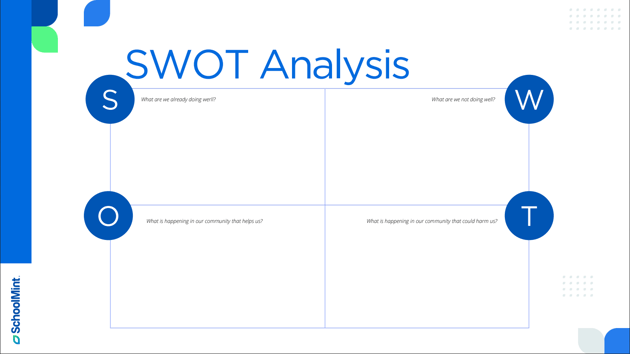What is a School SWOT Analysis — and How Can it Increase Enrollment?
With the constant challenges of how to increase enrollment in your public school or charter school, good “intel” is key. The more you understand about the marketplace and where your school sits within it, the more you’ll be able to create effective strategies to enroll more students.
In the business world, one of the most effective tools organizations use to assess where they stand is a SWOT analysis.
The term might sound goofy, but a school SWOT analysis can reveal incredibly useful information to help inform everything from your school’s marketing to future student enrollment campaigns.
What is a SWOT Analysis?
SWOT is an acronym for strengths, weaknesses, opportunities, and threats: the four critical components of self-awareness for any business or organization.
- Strengths and weaknesses deal with the internal aspects of your organization — those elements that you can control and improve upon.
- Opportunities and threats have to do with the external factors in your environment — those things over which you have no real control but which you can (and should) respond to.
Conducting an honest assessment of all four of these elements gives you a clearer understanding of your school as an entity and its position in a competitive marketplace, letting you know where to best target your energies as far as marketing.
Interested in receiving more content like this? Sign up for our enrollment-focused newsletter, the SchoolMint Insider, by clicking the button below.
When to Do a SWOT Analysis of a School
Before you pull out a whiteboard and jump into your self-evaluation, take a moment to step back and consider all points of view you’ll need to get a true picture of your school and your environment.
There’s no one-size-fits all formula for which perspectives you need. It all depends on your particular school.
Faculty members (both tenured and new), athletic directors, parents, and administrators would all be somewhat “standard” participants in this exercise.
For some schools, they may add additional perspectives. For example:
- A public school SWOT analysis would look different depending on whether the school is a charter or part of the local district.
- A SWOT analysis for a private school would include the perspective of the school’s fundraisers.
- A SWOT analysis of an elementary school would need to depend on parents and guardians more since they might have trouble getting specific feedback from younger students.
Figure out the right participants for your school SWOT analysis.
Once you’ve identified the key stakeholders in your school community to help you perform the analysis, find a time when you can meet free from interruptions.
A good time is often over the summer break or an extended holiday vacation, when the team won’t be distracted by the day-to-day (or, really, minute-to-minute) distractions that are part of running a school.
How to Do a SWOT Analysis of Your School
Once you’ve picked a time for the key members of your leadership team for an unhurried meeting, possibly with a third-party business consultant present to help guide the conversation, collect and review any current research about your school.
For instance:
- Surveys completed by parents or students
- Academic results
- Enrollment data
- Student retention rates
What gets measured gets managed.
The more data you have, the easier it will be to paint an accurate picture.
When your SWOT group is finally assembled with all the relevant data in hand, the brainstorming can begin.
During this phase, ask key questions about each of the four elements. Write down people’s responses somewhere everyone can see them.
Many schools are already equipped with smart boards that make it easy to save and share the information, but an old-school whiteboard works fine too. I recommend, however, that you tackle each topic one at a time in order to remain focused.
Some examples of what these questions might look like:
1. Strengths
- What are the main characteristics that drew parents to enroll their children here?
- What do the students and parents seem to like about our school?
- Which of our marketing campaigns have been most successful — and why?
- In which subjects do our students most excel?
- What are our greatest tangible assets (e.g., facilities, equipment, faculty, etc.)?
2. Weaknesses
- What are the primary reasons parents remove their children from our school?
- What are our most common complaints?
- What are our greatest internal needs (e.g., finances, equipment, software, etc.)?
- In which subjects are our students performing the worst?
3. Opportunities
- Which neighborhoods in our community are seeing the greatest influx of new residents?
- Are we the only school in the area that offers a specialized curriculum (e.g., STEM, IB, Classical)?
- Where do parents and students within our target demographics spend most of their time?
- How can we leverage marketing tools — like social media, email, direct mail, our website, and such — to connect to our target market in this area?
4. Threats
- Who is our competition in the community? What are they doing to recruit more students? Are any of our students leaving to enroll in those schools?
- What cost factors might be making it more difficult for us to compete (e.g., cost of software, materials, upkeep)?
- What economic challenges might people in our community be facing?
- Are there new schools in our area that might draw students away from our school?
- Are parents leaving our school for virtual options that we don’t offer?
Using Your SWOT Analysis for School Improvement
Once you have successfully identified the primary strengths, weaknesses, opportunities, and threats, compile it into an organized four section grid that lists everything for easy future reference.
The end result should look something like this:
P.S. You can download the above chart as well as watch a great video on SWOT analyses by signing up for SchoolMint Enrollment Academy. Click here to learn how you can get free, unlimited access to academy resources.
After you’ve created your school’s SWOT analysis, here comes the most important part: any time you have a big decision to make about future marketing plans, recruitment campaigns, or anything to do with future enrollment, refer to your school SWOT analysis.
Ask yourself these questions:
- How will this decision build on my strengths?
- How will this decision shore up my weaknesses?
- How does this decision respond to opportunities?
- How does this decision protect against threats?
You should have a good answer to one or more of those questions for every consequential decision you make.
By performing a SWOT analysis for your school and creating an action plan based on the results, you’ll have a clearer understanding of where your target market is and how to reach them more effectively.
You’ll also know how to play to your strengths and “lean in” to what attracts students to your school — and how to communicate those strengths to enroll more students like them.
Audit Your Current Marketing Efforts
To learn more about how SchoolMint can help you identify your school’s strengths, weaknesses, opportunities, and threats, check out our variety of school marketing and consulting services.
Share this
You May Also Like
These Related Stories

What Are Lead Magnets — and How Can They Boost Student Enrollment?

How a School Secret Shopper Can Improve Your Enrollment Process




